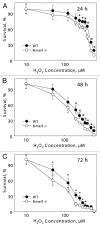Circadian clock protein BMAL1 regulates cellular senescence in vivo
- PMID: 22101268
- PMCID: PMC3272294
- DOI: 10.4161/cc.10.23.18381
Circadian clock protein BMAL1 regulates cellular senescence in vivo
Abstract
Deficiency of the circadian clock transcriptional factor BMAL1 results in the development of premature aging in mice. In agreement with the accelerated aging phenotype, we observed an increase in the number of senescent cells in different tissues (lungs, liver and spleen) of Bmal1(-/-) mice, which suggests the important role of BMAL1 in the control of senescence in vivo. However, no difference in the rate of proliferation and senescence between primary fibroblasts isolated from wild-type and Bmal1(-/-) mice has been detected, suggesting that BMAL1 does not play a significant role in replicative senescence in vitro. BMAL1 deficient fibroblasts had an increased sensitivity to hydrogen peroxide treatment, and reduced sensitivity to DNA damaging anticancer drugs etoposide and daunorubicin. Increased sensitivity of Bmal1(-/-) cells to oxidative stress was p53 independent and correlated with the disrupted regulation of reactive oxygen species (ROS) homeostasis in BMAL1 deficient cells: indeed, circadian oscillations of ROS level can be induced in wild-type but not in Bmal1(-/-) cells. We propose that BMAL1 is important for the regulation of oxidative stress and DNA damage responses, while deregulation of these processes upon BMAL1 deficiency leads to development of stress induced senescence in vivo.
Figures







Comment in
-
Brain and muscle ARNT-like protein BMAL1 regulates ROS homeostasis and senescence: a possible link to hypoxia-inducible factor-mediated pathway.Cell Cycle. 2012 Jan 15;11(2):213-4. doi: 10.4161/cc.11.2.18786. Epub 2012 Jan 15. Cell Cycle. 2012. PMID: 22223094 No abstract available.
Similar articles
-
Bmal1-deficient mouse fibroblast cells do not provide premature cellular senescence in vitro.Chronobiol Int. 2018 May;35(5):730-738. doi: 10.1080/07420528.2018.1430038. Epub 2018 Jan 26. Chronobiol Int. 2018. PMID: 29372841
-
BMAL1 modulates senescence programming via AP-1.Aging (Albany NY). 2023 Oct 10;15(19):9984-10009. doi: 10.18632/aging.205112. Epub 2023 Oct 10. Aging (Albany NY). 2023. PMID: 37819791 Free PMC article.
-
The E3 ubiquitin ligase STUB1 attenuates cell senescence by promoting the ubiquitination and degradation of the core circadian regulator BMAL1.J Biol Chem. 2020 Apr 3;295(14):4696-4708. doi: 10.1074/jbc.RA119.011280. Epub 2020 Feb 10. J Biol Chem. 2020. PMID: 32041778 Free PMC article.
-
Emerging Insight Into the Role of Circadian Clock Gene BMAL1 in Cellular Senescence.Front Endocrinol (Lausanne). 2022 Jun 6;13:915139. doi: 10.3389/fendo.2022.915139. eCollection 2022. Front Endocrinol (Lausanne). 2022. PMID: 35733785 Free PMC article. Review.
-
Effects of BMAL1 Manipulation on the Brain's Master Circadian Clock and Behavior.Yale J Biol Med. 2019 Jun 27;92(2):251-258. eCollection 2019 Jun. Yale J Biol Med. 2019. PMID: 31249486 Free PMC article. Review.
Cited by
-
Inactivation of the intrinsic muscle clock does not cause sarcopenia.J Physiol. 2016 Jun 1;594(11):3161-2. doi: 10.1113/JP272127. J Physiol. 2016. PMID: 27246551 Free PMC article. No abstract available.
-
Impact of the circadian clock on the aging process.Front Neurol. 2015 Mar 6;6:43. doi: 10.3389/fneur.2015.00043. eCollection 2015. Front Neurol. 2015. PMID: 25798127 Free PMC article. Review.
-
Scutellaria baicalensis Georgi regulates REV-ERBα/BMAL1 to protect against skin aging in mice.Front Pharmacol. 2022 Sep 30;13:991917. doi: 10.3389/fphar.2022.991917. eCollection 2022. Front Pharmacol. 2022. PMID: 36249807 Free PMC article.
-
ARNTL hypermethylation promotes tumorigenesis and inhibits cisplatin sensitivity by activating CDK5 transcription in nasopharyngeal carcinoma.J Exp Clin Cancer Res. 2019 Jan 8;38(1):11. doi: 10.1186/s13046-018-0997-7. J Exp Clin Cancer Res. 2019. PMID: 30621723 Free PMC article.
-
Circadian clock function is disrupted by environmental tobacco/cigarette smoke, leading to lung inflammation and injury via a SIRT1-BMAL1 pathway.FASEB J. 2014 Jan;28(1):176-94. doi: 10.1096/fj.13-232629. Epub 2013 Sep 11. FASEB J. 2014. PMID: 24025728 Free PMC article.
References
Publication types
MeSH terms
Substances
Grants and funding
LinkOut - more resources
Full Text Sources
Molecular Biology Databases
Research Materials
Miscellaneous
